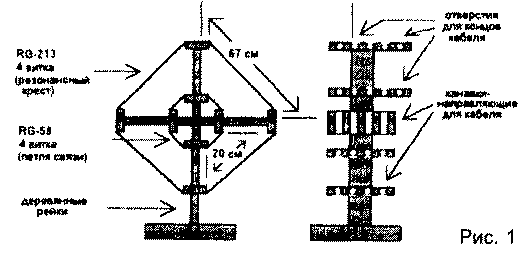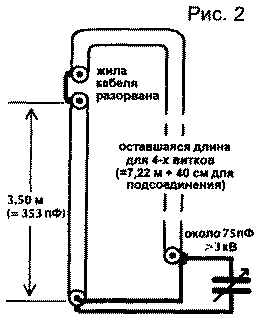Who is forced to abandon outdoor antenna (for example after moving), things like ham-shortwave is very bad. However, there is always something to do, in order, nevertheless, to remain QRV.
Typical solution - magnetic antenna. Despite satisfactory experience with two improvised loop indoor antenna for bands 80 to 10 meters, the hope that something similar can be done for 160m, was very weak.
On the basis of known sketch Annecke and made it loop for 80...30 m, I just wanted to increase the number of turns of up to four (double). Then we would have to leave unchanged the capacitor 400 pF, which was used previously.
But that is the theory. But if the failure? Four turns of copper tube section 18 mm with coil diameter of 17 cm - not too expensive for errors? After some thought I came to a not very expensive solution is to use a thick coaxial cable. Total material consumption:
- 4 wooden slats 20 mmh mm;
- 12 m coaxial cable RG-213;
- 4m coaxial cable RG-58;
- 1 variable capacitor 100 pF with the distance between the plates 2...3 mm;
- 1 coaxial connector.
How does the design shown in Fig.1...3. The cross of wooden planks with a transverse plates, in which I sawed through the grooves, holds a resonant loop, consisting of four turns of RG-213. Upper limit (for resonant loop and loop connection) are on the edges of the two holes to hold the cable ends and three grooves between them. The length of the side of the coaxial cable in an almost square suspension is 67 see someone this very frustrating that I do not give the dimensions of the wooden cross, I must say that I really respect the old man of Pythagoras and, for that matter, important is only the dimensions of the coaxial cable.

Screen sheath of the coaxial cable forms a frame loop. Lived cable is broken at a distance of 3.50 m from one end. The result is a capacity value of about 353 pF, connected in parallel with the variable capacitor.

The variable capacitor is connected to both ends of the cable sheath RG-213. For all connections, you must use thick copper wire with a diameter of at least 10 mm2.

For reasons of convenience, the coil is placed on the same straps and also has four spiral at a distance of 8 cm from each other. The length of the lateral sides are equal here 20 cm RG-58 Cable with both ends of the braid is connected to the input coaxial connector.
On the resonance SWR = 1,2. The bandwidth for VSWR<2 is less than 9 kHz. So you need to adjust the variable capacitor in the resonance when tuning around the band. Perhaps this is the only disadvantage of magnetic loops!
After I went 15 consecutive days in the air (in January 1995) one morning, one evening about one hour, I spent 43 QSOs with stations of the fourteen countries: DL, SM, SP, G, GL, GM, F,, 1, OK, OE, ON, 9A, S5. Unfortunately, I couldn't cause many stations that I heard, because they purposefully called "CQ DX". Yet, my own CQ resulted in only a few QSOs.
The existing noise level can be reduced by 2...3 points a small change in the location of antenna rotation. For the range of 160 m and 80 m) is a true blessing!
Since the zeros of the antenna (or rather, almost zeros) is very narrow, the orientation of the antenna is quite uncritical.
In conclusion I would have drawn the following conclusions:
- this is not superintende, but I am QRV on 160 m;
- the cost and footprint of the antenna of the minor;
- as a symmetric antenna having a high quality factor, it greatly increases the security against BCI/ TVI (no stray currents HF);
- reduced atmospheric disturbances and local QRM;
- the placement does not depend on weather conditions.
Editor's note
Instead of RG-213, you can use any 50-Ohm cable with outer diameter >13 mm.
Literature
Author: W. Schreglmann (DJ5QY); Publication: N. Bolshakov, rf.atnn.ru






